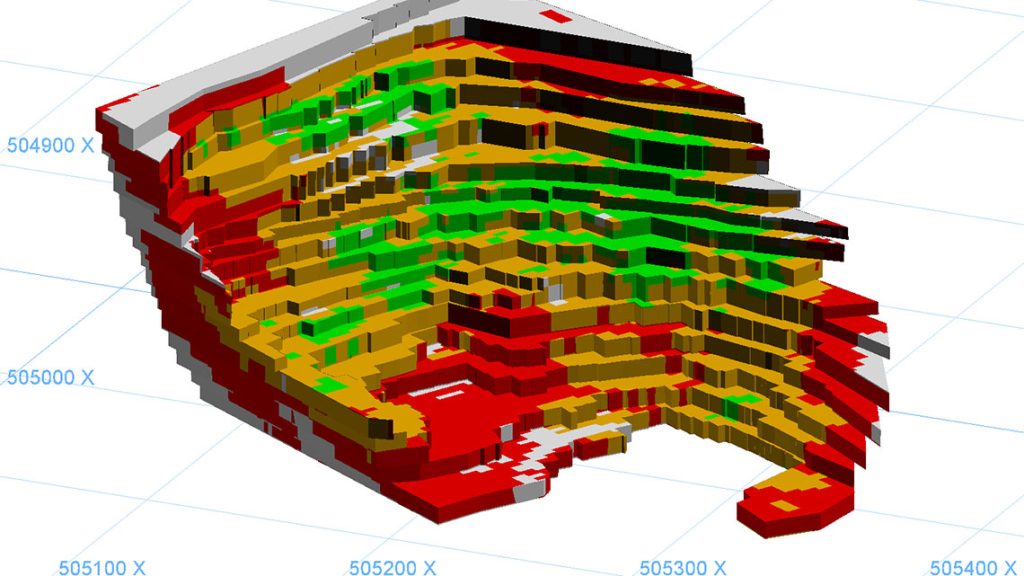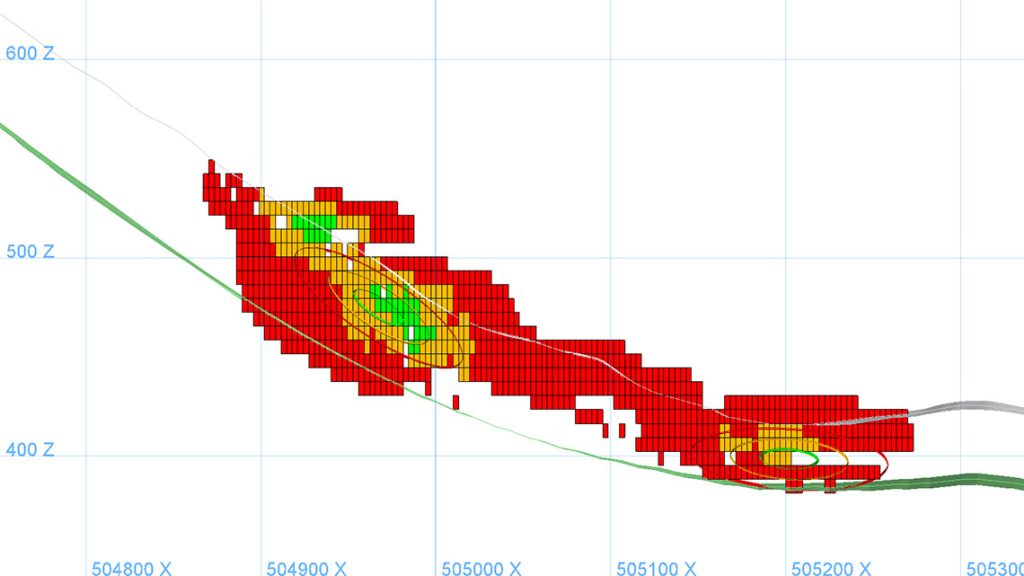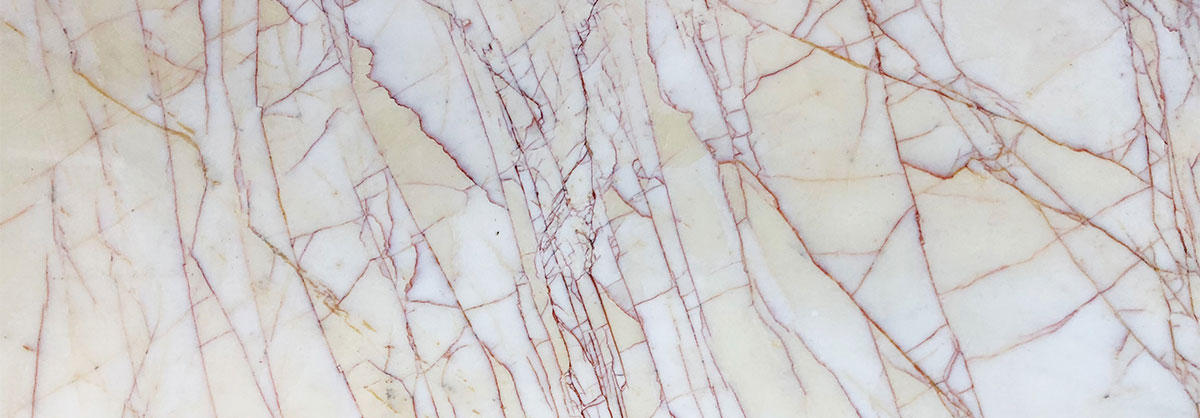December 2018 Issue Index
Quality-based resource estimation
Maptek Vulcan is being used at a marble quarry in northeastern Greece for resource and reserve estimation using quality indicators.
The use of standard estimation and modelling software tools in estimating marble quarry reserves poses several challenges. Reserves are based on marble quality categories, which are unique for each deposit. These categories represent visual and physical aspects such as colour, texture and fractures.
Classification is performed by experienced personnel and is based on much smaller samples than the slabs of marble produced. Furthermore, the available information is mostly qualitative, leading to further complications in the application of geomathematical estimation methods.

Iktinos Hellas SA used Maptek Vulcan in the estimation of marble reserves based on interpolating quality indicator values from drillhole and quarry face samples to 3D blocks.
The procedure is applied in all working quarries, as typified by this case study. The Platanotopos quarry in northeastern Greece is in public forest land, at 380–540 m elevation.
Geology
The Platanotopos quarry contains calcitic marbles, gneiss and gneissic schists which have no commercial value and are not exploited. Interest is focused on dolomitic marbles, which occur as lenses enclosed by alternating gneissic schist layers and calcitic marbles.
The marble-bearing horizon has a regular strike, with dips between 25° and 30°. The lensoid dolomitic microcrystalline marbles are massive, white, fine-grained and traversed by red-yellow ‘spider-web’ fractures filled with secondary iron oxides and hydroxides. Because the marbles are massive, large slabs can be recovered with minimal production of waste material. The weathered top 1–2 m of the deposit has a low recovery factor for marketable marble.
Quarry production is scheduled for 7,000–10,000 m3 per annum, with an estimated operation life of 15 years. The marble, known as ‘Golden Spider’, has very good physical and mechanical properties and can take a very high polish.
The blocks from the Platanotopos quarry are 6 × 2.8 × 7 m. Quality grading is initially based on colour: gold, yellow or red. Further grading categorises the different spider-web textures. Each block is then classified based on defects such as fractures, dendrite zones, brown lines, discolourings or marks, and a final quality is assigned according to a combination of grading types.
Data used in the study
Data used in the resources and reserves estimation includes the original and current topography, as well as diamond drillhole samples and sections on quarry faces, which are analysed every metre as to the marble quality.
A total of 1684 one-metre samples, from 47 sections and 45 drillholes, was used in reserve estimation. The data covered the extent of the estimated final pit, and was validated in Vulcan for collar location and overlapping intervals.
Methodology
The estimated volume of the final excavation was designed per bench (level) starting from the existing quarry morphology. The design of each of the 16 benches was modelled as a solid triangulation. These solids were visually checked and validated using triangulation topology checks (self-crossing, opening, inconsistencies) to ensure suitability for volumetric calculations.
The drillhole and section sample database was configured with extra fields (indicators) to allow the interpolation of arithmetic values. Specifically, fields were added representing the different marble qualities based on original colour, texture, fracture and tectonism.

Tectonism is handled separately because the different orientations of large-scale tectonism require a different search ellipsoid orientation. This is combined with initial qualities to derive the final quality classifications, with downgrading as necessary based on the estimated value of this field.
After calculation of initial quality and tectonism categories, the location of each sample is calculated and a weighting factor is assigned. More weight is given to face sections as quality assessment is performed on a surface larger than the drill core and therefore better approaches the actual quality in that location. Weighting factors are used to further assess samples during interpolation.
Quality class field values were interpolated using the inverse distance squared method as implemented in a Vulcan block model. The estimated volume is divided into blocks of the same size. Block dimensions were configured based on the marble volumes extracted separately at the Platanotopos quarry.
In each block, the percentage of each marble quality was estimated using neighbouring samples. These samples are selected around each block using search ellipsoids oriented according to the geological features of the deposit. A special Vulcan function was used to calculate the appropriate ellipsoid orientation for each block, taking into account reference surfaces that define folding.
Generalisation of qualities was considered necessary as the limited sampling does not allow for a more detailed analysis of reserves to the original quality categories produced by the quarry. Reported waste quantities are the remaining bench volumes, which cannot be estimated using the available sampling and the limitations set by the reserve categories.
A considerable part of the waste and the Inferred Resources can potentially be upgraded in the future with additional drilling, which will provide a clearer and more detailed picture in areas where there are currently no samples.
This method gives Iktinos Hellas SA reliable results according to international standards of Resources/Reserves reporting. Future work will include integration of historical production data with the quality estimation process and implementation of an appropriate production quality control system that will produce the necessary data to improve the current quality models and reserve classification.
Thanks to
C. Albanopoulos, Iktinos Hellas SA
and Ioannis Kapageridis, Technological Educational Institute of Western Macedonia
Excerpt from paper published in Journal of the Southern African Institute of Mining and Metallurgy, Volume 118, January 2018

